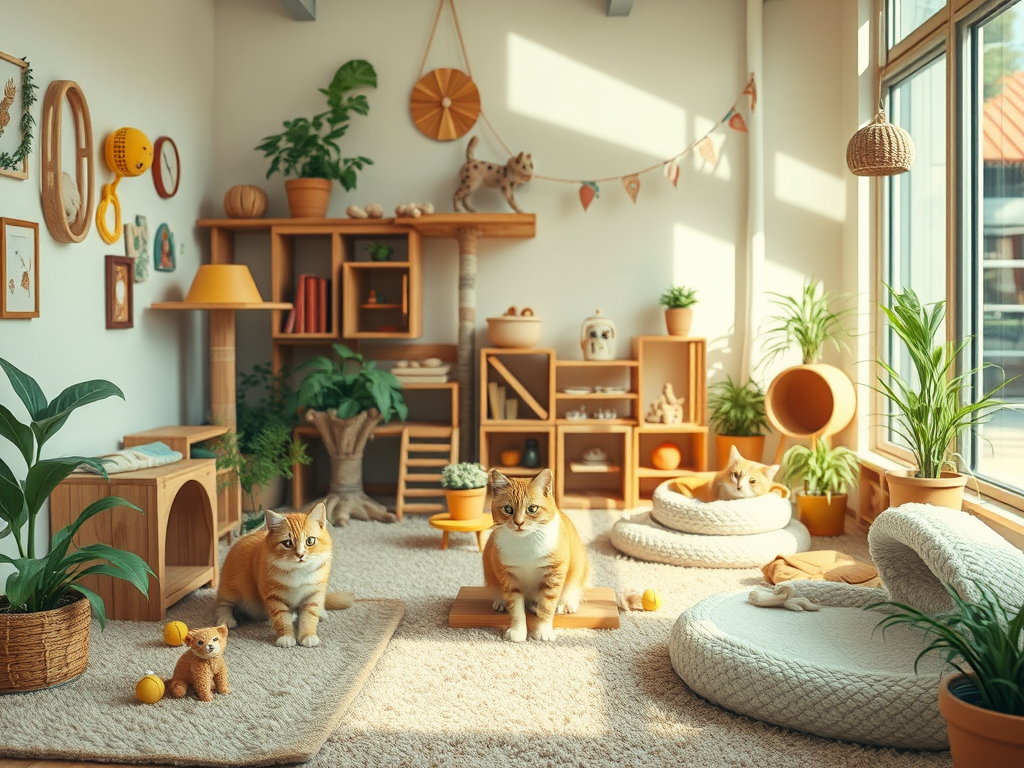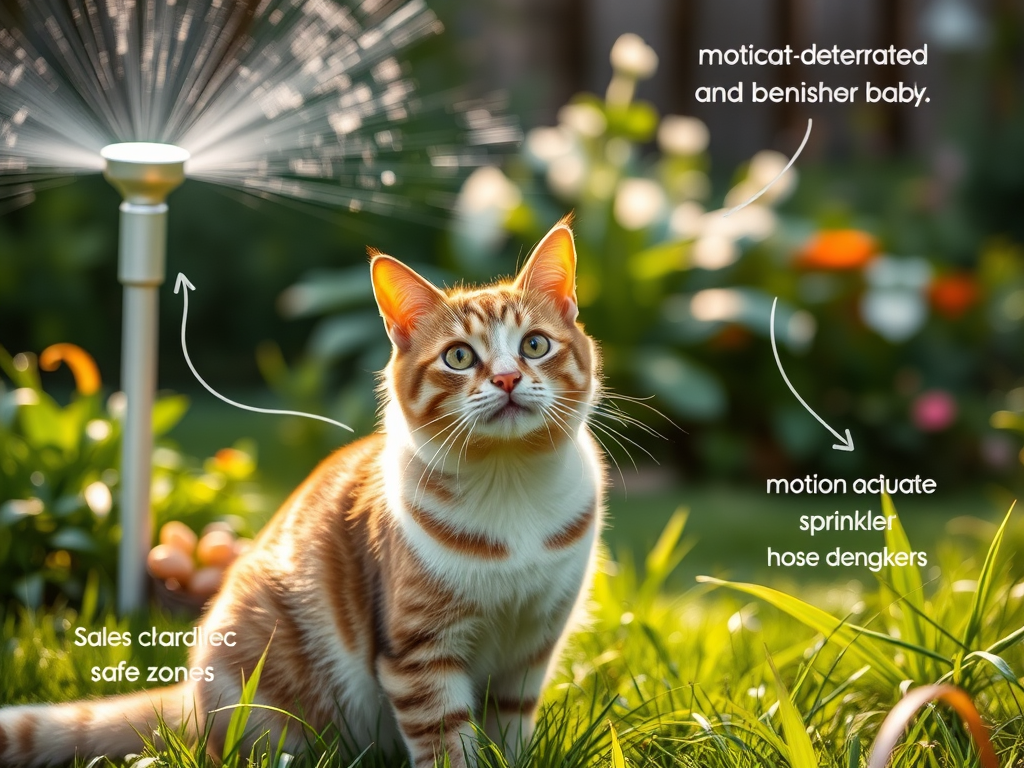Effective Strategies to Reduce Your Cat’s Natural Hunting Behavior
Reducing Your Cat’s Hunting Impact on Wildlife: Cats are instinctual hunters, a trait inherited from their ancestors that is integral to their nature. However, as a responsible pet owner, you can cultivate a secure indoor environment that satisfies their hunting instincts while safeguarding local wildlife. By creating enriching spaces and activities that stimulate their senses and instincts, you can keep your feline companion actively engaged and happy without endangering local fauna. This approach ensures your cat remains entertained and satisfied, allowing their natural behaviors to flourish in a safe manner.
Incorporating interactive toys into your cat’s playtime can greatly enhance their indoor hunting experience. Consider investing in feather wands, laser pointers, and battery-operated mice that can keep your pet engaged for prolonged periods. These toys effectively simulate natural hunting patterns, allowing your cat to track, chase, and pounce, which is crucial for their mental stimulation and physical fitness. By providing engaging toys, you not only entertain your cat but also support their overall health by allowing them to expend energy in a positive and constructive manner.
Transform your living space into a feline-friendly playground by setting up obstacle courses comprising boxes, tunnels, and shelves. This creative setup encourages your cat to explore and engage in physical activity, enabling them to climb, jump, and investigate different environments. As naturally curious animals, cats thrive in settings that allow for exploration. By offering varied spaces for them to investigate, you effectively recreate their wild instincts, providing them with a thrilling adventure right in your home.
Don’t overlook the benefits of puzzle feeders. These innovative devices not only challenge your cat mentally but also replicate the effort they would typically expend while hunting. By integrating treat-dispensing puzzles into your cat’s feeding routine, you can keep their minds active while delivering a fun and rewarding experience. This strategy not only entertains your pet but also encourages healthy eating habits, as they learn to work for their food, thus reducing their inclination to hunt.
Prioritizing playtime is essential in your home. Engaging in social interaction through play is vital for fostering a strong bond between you and your cat. Make it a routine to schedule dedicated play sessions, using the same toys they enjoy during solo playtime. This shared engagement not only alleviates any pent-up energy your cat may experience but also deepens your connection, making playtime a rewarding experience for both of you, enhancing your overall relationship.
Creating a stimulating indoor environment for your cat is entirely feasible with a bit of creativity and commitment. Your home can evolve beyond a mere shelter into an exciting landscape that satisfies their inherent hunting instincts while ensuring their safety from outdoor dangers. With careful planning and thoughtfulness, you can nurture a happy and fulfilled indoor cat.

Leash Training: Discovering New Outdoor Adventures for Your Cat
Introducing leash training opens up a world of safe exploration for your cat. While walks are commonly associated with dogs, cats can also enjoy the great outdoors with the right training and a bit of patience. By familiarizing your feline friend with a harness and leash, you can provide them with the chance to experience nature while remaining secure in your control.
Start your leash training journey with a well-fitted harness that is comfortable for your cat. It’s crucial to let your pet become accustomed to the harness before attempting to put it on. Allow them to sniff and examine the harness, which will help alleviate any anxiety they may have. Gradually introducing the harness at their pace fosters positive associations, making the entire process smoother and more enjoyable for your cat.
Once your cat has grown comfortable with the harness, attach a lightweight leash and begin practicing indoors. This controlled environment will help them adjust to the sensation of wearing a leash and build their confidence. Be patient, as some initial resistance is normal; taking your time is essential for helping your cat adapt to this new experience positively.
When you venture outside for the first time, choose a peaceful and secure area, such as your backyard or a quiet park. Ensure the location has minimal traffic and distractions to help your cat feel safe. Start with brief outdoor sessions to avoid overwhelming your pet, gradually extending the duration as they become more comfortable exploring their new environment.
Supervised outdoor time enriches their lives, allowing them to enjoy the sights, sounds, and scents of nature without posing a threat to local wildlife. Imagine the delight on your cat’s face as they discover new experiences in a secure setting. This bonding time not only enhances their quality of life but also fortifies your relationship with them.
Real-life accounts from fellow cat owners serve as excellent motivation. Many have initially doubted whether their cats would take to leash walking, but with consistency and positive reinforcement, they found success. Celebrate each small achievement as a step toward broadening your cat’s horizons while ensuring their safety.
By integrating leash training into your cat’s routine, you are blending outdoor enjoyment with wildlife protection. This balanced approach allows your cat to explore their environment while fostering a sense of security in their surroundings.
Building Safe Outdoor Spaces: The Advantages of Catios
Outdoor cat enclosures, commonly known as catios, provide an ideal solution for adventurous cats yearning for outdoor experiences without the inherent risks. These secure spaces allow your feline companions to enjoy the fresh air while ensuring their safety and protecting local wildlife.
Constructing or purchasing a catio can be customized to fit your available space and budget. Options range from simple balcony enclosures to more elaborate backyard structures. The primary focus should be on ensuring that the design is escape-proof, as safety should always be the top priority in creating a secure environment for your cat.
When designing your catio, consider adding multiple levels and cozy hiding spots. Cats thrive in environments that offer vertical spaces and places to retreat. By incorporating platforms, ramps, and hammocks, you can transform a basic enclosure into an engaging paradise that reflects their natural habitat, enhancing their overall enjoyment.
Enhancing the sensory experience within the catio can also be advantageous. Introducing elements like cat grass, scratching posts, or logs can create a stimulating environment filled with diverse textures and scents. This sensory enrichment keeps your cat engaged and satisfied while allowing them to enjoy the outdoors in a controlled setting.
Regular maintenance is vital for ensuring the safety of your catio. Consistently check for signs of wear and tear, including the integrity of the mesh, structural stability, and locks. Cats, being naturally curious, may test the boundaries of their enclosure, so keeping it well-maintained is essential for their safety and well-being.
With a catio, your feline friend can indulge in sunbathing, climbing, and observing wildlife without posing a threat to local ecosystems. They can enjoy the warmth of the sun and watch birds from the safety of their outdoor haven, remaining content while local wildlife stays protected.

Proven Behavioral Training Techniques to Deter Hunting Instincts
Training your cat to minimize their hunting behavior may seem daunting, but with the right techniques, it can be a manageable task. The first step involves understanding their natural instincts and the behaviors that drive them to hunt, which is crucial for implementing effective training strategies.
Utilizing technology can significantly enhance your training efforts. Consider using motion-activated deterrents, such as sprinklers or noise-makers, to establish boundaries that discourage hunting without disrupting other activities. Strategically zoning your yard into safe areas can redirect your cat’s attention away from potential prey and help maintain a harmonious environment.
Positive reinforcement plays a vital role in modifying your cat’s behavior. Reward them for non-hunting actions with treats or affection. For instance, if your cat comes when called or refrains from pursuing a potential target, offer them a tasty treat or extra affection. This method encourages them to repeat desirable behaviors while mitigating their instinctive urges to hunt.
Incorporating clicker training can also be a powerful tool. This technique involves associating a distinct sound with positive actions, enabling your cat to connect their behavior with rewards. By clicking when they exhibit desired behavior, you can reinforce good habits and clarify expectations effectively.
For personalized support, consider consulting with feline behavior specialists. They can provide tailored advice that addresses specific challenges, helping you and your cat coexist harmoniously while respecting local wildlife.
The goal of deterrents and training isn’t punishment but guidance, steering your cat toward behaviors that prioritize their safety and environmental conservation. With consistency and patience, you can redirect their instincts, leading to safer outdoor interactions for both your cat and local wildlife.
Nutritional Strategies to Reduce Hunting Drives in Cats
The type of food you provide and the feeding methods you adopt can have a significant impact on your cat’s hunting instincts. Surprisingly, even a well-fed cat might still display hunting behaviors; however, the way you feed them can help mitigate this drive effectively.
Free feeding, where food is available throughout the day, may not be appropriate for every cat. Instead, consider implementing a scheduled feeding routine. By establishing consistent mealtimes, your cat may be less inclined to hunt, as they learn to associate food with specific times of the day, thereby reducing the motivation to seek out prey.
Implementing interactive feeding strategies can be transformative for your cat’s behavior. Utilizing food puzzles or dispensers can mimic the act of hunting, requiring your cat to ‘work’ for their meals. This keeps them mentally and physically stimulated while positively channeling their energy, allowing their natural instincts to express themselves in a safe manner.
Pay attention to the nutritional quality of their food as well. A diet rich in protein and low in carbohydrates aligns better with a cat’s natural dietary needs, potentially leading to a decrease in hunting behaviors. Collaborating with a veterinarian to tailor your cat’s diet can ensure their nutritional requirements are effectively met.
Finally, offering a variety of food types can cater to their innate curiosity and desire for novelty. Alternating between dry kibble, wet food, and raw diets keeps mealtime interesting, reducing the temptation to seek excitement beyond their food dish.
Feeding strategies extend beyond mere sustenance; they serve as a powerful tool for managing your cat’s behavior. By adjusting how and what you feed them, you can effectively lessen their inclination to hunt while keeping them satisfied and healthy.

Encouraging Community Responsibility for Cat Conservation
Cats are beloved companions, and as their caretakers, we have a responsibility to ensure they coexist harmoniously with local wildlife. By embracing community efforts and personal accountability, we can significantly reduce the ecological impact of free-roaming cats.
Engaging with local conservation organizations is a fantastic way to stay informed about wildlife-friendly practices. Many communities offer educational workshops for cat owners, highlighting the ecological consequences of allowing cats to roam freely and providing solutions to mitigate these effects.
Consider starting or participating in neighborhood discussions or social media groups focused on responsible pet ownership. Sharing resources, tips, and experiences can foster a more wildlife-conscious community, creating a supportive environment for all pet owners while promoting responsible practices.
One proactive approach involves establishing cat-friendly zones within communal gardens or parks. These designated areas can include enclosures or supervised play spaces, ensuring a safe environment for both cats and wildlife. This collaborative effort raises awareness and promotes positive interactions between pets and nature.
Incorporating family-friendly initiatives, such as sticker campaigns or educational contests for children and teens, can help raise awareness about responsible pet ownership and the importance of coexisting with nature.
Lead by example at home by implementing the strategies you’ve learned. Whether it’s leash training, building catios, or modifying feeding practices, demonstrating a commitment to a harmonious relationship between your cat and the environment can inspire others to follow suit.
By combining individual actions with community-based initiatives, we can create a supportive network that balances our cats’ needs with ecological stewardship. Together, we can cherish our pets while respecting and protecting the wild spaces around us.
The Article: Minimize Your Cat’s Hunting Impact Appeared First On Unity Pets.
The Article Minimize Hunting Impact of Your Cat Effectively Was Found On https://limitsofstrategy.com




Comments are closed